4.1 Register
The cultural significance of the lighthouse resides in its fabric, and also in its intangible aspects – such as the meanings people ascribe to it, and the connections to other places and things. The survival of its cultural value depends on a well-informed understanding of what is significant, and on clear thinking about the consequences of change. The Burra Charter15 sets out good practice for conserving cultural significance.
Criterion listed under ‘Heritage Significance’ refer to the criterion satisfied within the specific Commonwealth heritage listing.
Lighthouse feature: Lantern roof
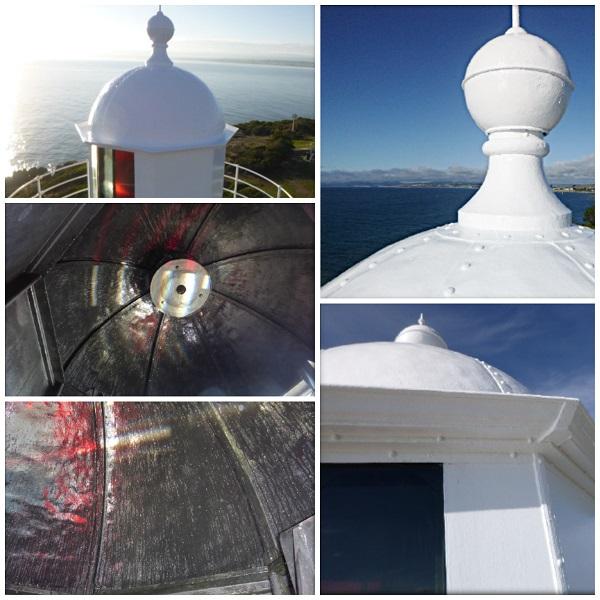
Description and condition
1889 Chance Bros part-spherical dome of copper sheets lapped and screwed to ribs
- Ribs – Chance Bros cast iron radial ribs
- Inner Skin – none
- Ventilator – ball type (vent holes sealed). New stainless steel vent was installed in February 2019 to reduce the moisture accumulation previously occurring in the dome
- Lightning Conductor – vertical spike on top of ball ventilator
- Gutter – polygonal fabricated gutter attached to ring of cast iron pieces bolted together
- Handrails – none
- Drip tray – copper dish suspended under ventilator, with central hole for heat tube
| Finish | painted |
| Condition | intact and sound |
| Integrity | high |
| Significance | high |
| Maintenance | keep in service, prepare and repaint at normal intervals |
| Rectification works | investigate moisture accumulation in dome and implement measures to reduce moisture accumulation |
Lighthouse feature: Lantern glazing
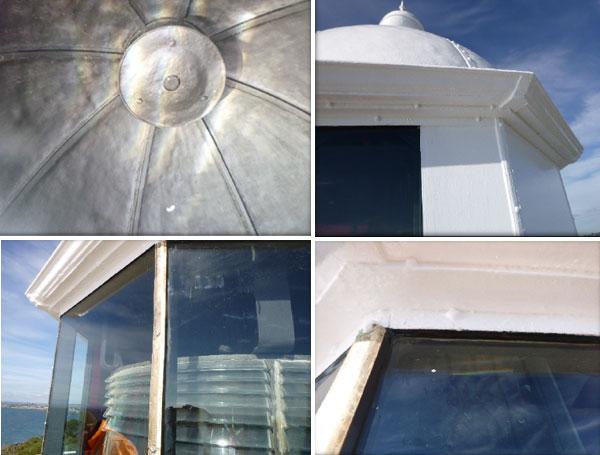
Description and condition
1889 Chance Bros, polygonal in form.
- Panes – flat rectangular glass, one tier.
- Astragals – Chance Bros vertical astragals of rectangular section iron, bolted to gutter ring at top, and to lantern base below.
- Downpipes – one downpipe discharging to balcony floor.
| Finish | astragals and glazing strips painted |
| Condition | intact and sound |
| Integrity | high |
| Significance | high |
| Maintenance | keep in service, reglaze as necessary, prepare and repaint at normal intervals |
| Rectification works | none |
Heritage significance: High
The lantern glazing is an historic and essential part of a lighthouse associated with the development of Tasmanian townships (criterion a).
The lantern glazing contributes to the aesthetic value of the lighthouse (criterion e).
Lighthouse feature: Lantern base
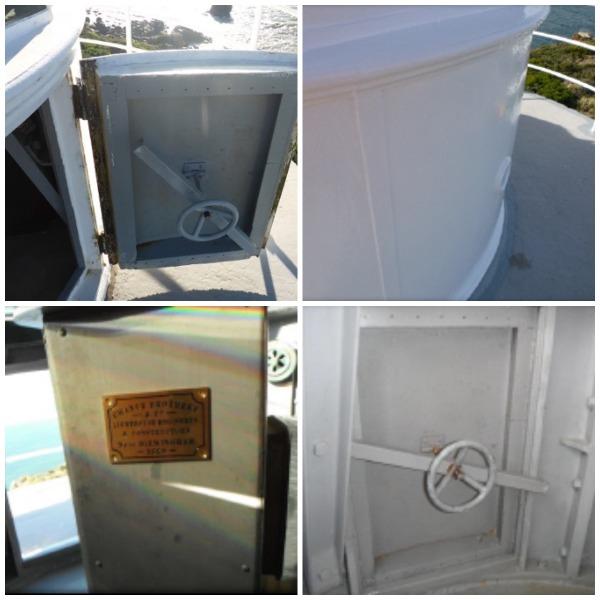
Description and condition
1889 Chance Bros, cylindrical in form. Curved panels of cast iron bolted together with flanged joints.
- Internal lining – none (removed).
- Vents – round air inlets cast as part of wall panels. Cast iron air trunks bolted on inside, each fitted with one brass regulator.
- Door – Chance Bros iron door with timber frame inside. Copper alloy hinges. Secured with steel strong-back, steel stud and hand-wheel.
| Finish | painted |
| Condition | intact and sound |
| Integrity | high |
| Significance | high |
| Maintenance | keep in service prepare and repaint at normal intervals |
| Rectification works | none |
Heritage significance: High
The lantern base is both an original and essential part of a lighthouse associated with the devleopment of Tasmanian townships (criterion a).
Lighthouse feature: Lantern floor
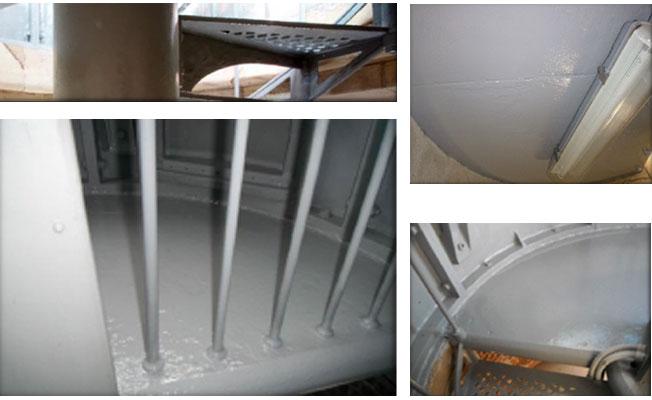
Description and condition
Slate slab floor supported on sandstone cornice at the top of the tower wall, and on central iron post.
| Finish | painted |
| Condition | intact and sound |
| Integrity | high |
| Significance | high |
| Maintenance | keep in service prepare and repaint at normal intervals |
| Rectification works | none |
Heritage significance: High
The lantern floor is an historic and essential part of a lighthouse associated with the development of Tasmanian townships (criterion a).
Lighthouse feature: Lens assembly
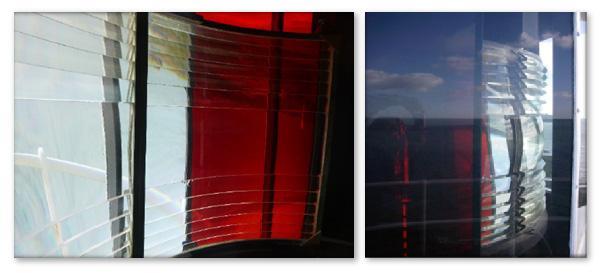
Description and condition
700mm focal radius fixed (non-rotating) lens assembly of glass and gunmetal, with array of reflecting prisms on the landward side.
Supported by steel brackets attached to the lantern base, and by brackets attached to the lantern roof gutter ring.
| Condition | intact and sound |
| Integrity | high |
| Significance | high |
| Maintenance | keep in service clean at normal intervals |
| Rectification works | none |
Heritage significance: High
The lens assembly is an historic and essential part of a lighthouse associated with the development of Tasmanian townships (criterion a).
Lighthouse feature: Light source
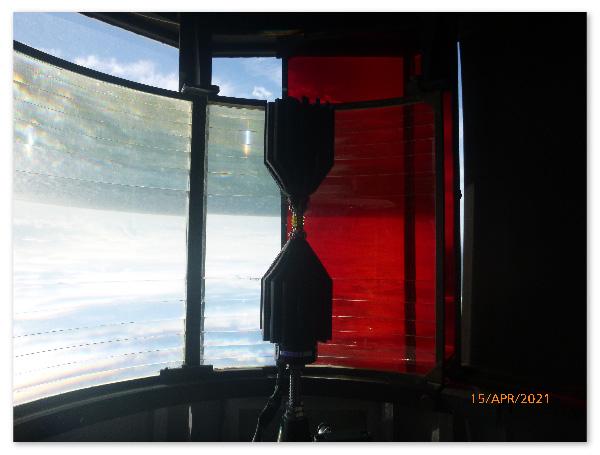
Description and condition
Lamp: 12V 100W C8 Halogen LP PR30s in CR Control S-2086BLR 10amp lampchanger.
| Condition | not assessed |
| Significance | low |
| Maintenance | not assessed |
| Rectification works | none |
Heritage significance: Low
Lighthouse feature: Pedestal
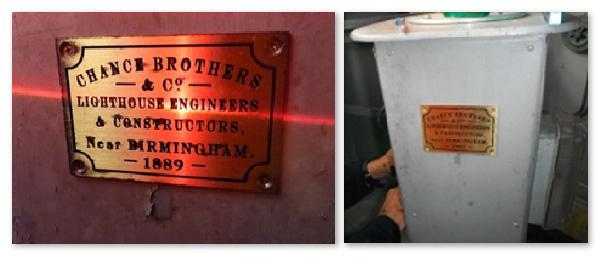
Description and condition
Fabricated metal box pedestal supporting the lamp changer (but not the lens assembly). Replica Chance Bros. maker’s plaque fit to pedestal.
| Finish | painted |
| Condition | intact and sound |
| Integrity | high |
| Significance | low |
| Maintenance | none |
| Rectification works | none |
Heritage significance: Low
Lighthouse feature: Balcony floor
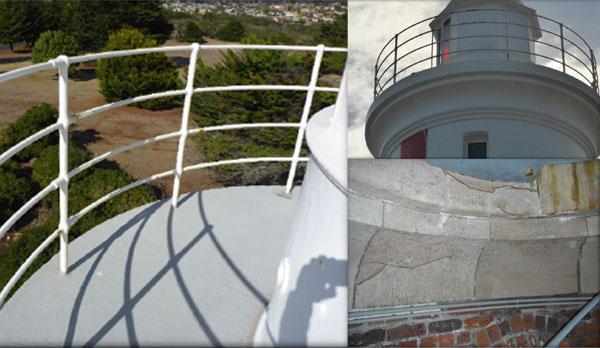
Description and condition
1889 sandstone slabs supported by tower wall and cornice.
| Finish | membrane painted |
| Condition | intact and sound, but there is evidence of previous water penetration into the masonry wall below. |
| Integrity | high |
| Significance | high |
| Maintenance | keep in service monitor and maintain joint seals prepare and repaint at normal intervals |
| Rectification works | none |
Heritage significance: High
The balcony floor is an original and essential part of a lighthouse associated with the development of Tasmanian townships (criterion a)
Lighthouse feature: Balcony balustrade


Description and condition
1889 wrought iron balusters with four iron pipe rails.
| Finish | painted |
| Condition | intact and sound |
| Integrity | high |
| Significance | high |
| Maintenance | keep in service prepare and repaint at normal intervals |
| Rectification works | none |
Heritage significance: High
The balcony balustrade is an original and essential part of a lighthouse associated with the development of Tasmanian townships (criterion a).
Lighthouse feature: Walls

Description and condition
1889 brick walls, built with the internal face plumb so that the internal volume is of constant diameter. The lower part of the tower is built in two skins, which are merged into one above the door opening.
Two iron reinforcing bands built into the bed joints of the brickwork just below the intermediate floors, marked by a crack on the outside and visible in places inside. A new stainless steel vent was installed in 2019 to reduce moisture accumulation throughout the tower.
| Finish | outside: painted inside: paint removed by sandblasting |
| Condition | signs of water penetration throughout the tower moderately severe erosion of internal surface in places by sand blasting otherwise intact and sound |
| Integrity | high |
| Significance | high |
| Maintenance | keep in service monitor condition of pointing and brickwork |
| Rectification works | none |
Heritage significance: High
The tower walls are an original and essential part of a lighthouse associated with the development of Tasmanian townships (criterion a).
The tower walls contribute to the aesthetic value of the lighthouse (criterion e).
Lighthouse feature: Windows

Description and condition
Eight original window openings with recent stainless steel frames built into brickwork, with stainless steel casement sashes secured with stainless steel screws. Lower two windows blanked out with stainless steel sheeting.
| Finish | outside: frames and sashes painted inside: bare metal glass: clear |
| Condition | intact and sound |
| Integrity | high |
| Significance | window openings: high frames and sashes: low |
| Maintenance | keep in service prepare and repaint at normal intervals |
| Rectification works | none |
Heritage significance: High
The tower windows are original and essential parts of a lighthouse associated with the development of Tasmanian townships (criterion a).
Lighthouse feature: Door

Description and condition
1889 timber framed and sheeted door hung in timber door frame. Weather proof ventilation and aluminium security mesh replaced with new stainless steel vent.
Original rim lock in place but disabled, with brass knobs inside and out. Secured with modern cylinder deadlocking rim lock.
Builder’s plate fixed to transom inside.
- Plaque – Brass plate screwed to transom over door, engraved THIS LIGHTHOUSE WAS ERECTED IN THE YEAR 1889 BY J & R DUFF, CONTRACTORS, HOBART
| Finish | painted |
| Condition | intact and sound |
| Integrity | high |
| Significance | high |
| Maintenance | keep in service prepare and repaint at normal intervals |
| Rectification works | none |
Heritage significance: High
The tower door is an original and essential part of a lighthouse associated with the development of Tasmanian townships (criterion a).
Lighthouse feature: Intermediate floors

Description and condition
Two 1889 part floors forming stair landings. Slate floor slabs supported on rolled steel beams built into the tower walls.
| Finish | painted |
| Condition | old, stable crack in the slate floor otherwise intact and sound |
| Integrity | medium |
| Significance | high |
| Maintenance | keep in service prepare and repaint at normal intervals |
| Rectification works | none |
Heritage significance: High
The intermediate floors are an original and essential part of a lighthouse associated with the development of Tasmanian townships (criterion a).
Lighthouse feature: Stairs
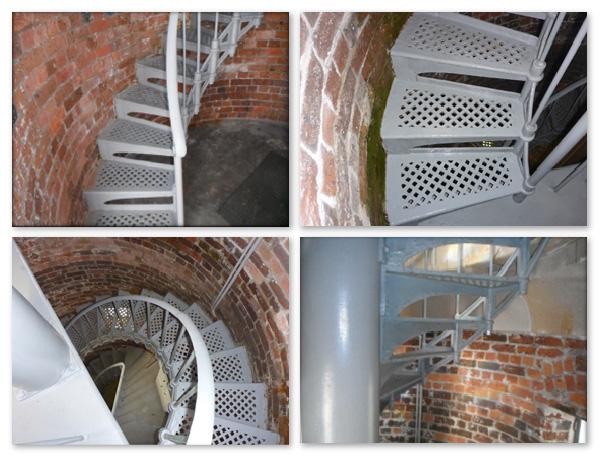
Description and condition
1889 geometric stair with cast iron treads/risers built into the tower wall, and wrought iron handrail and stanchions.
| Finish | painted |
| Condition | intact and sound |
| Integrity | high |
| Significance | high |
| Maintenance | keep in service prepare and repaint at normal intervals |
| Rectification works | none |
Heritage significance: High
The tower stairs are an original and essential part of a lighthouse associated with the development of Tasmanian townships (criterion a).
Lighthouse feature: Ground floor
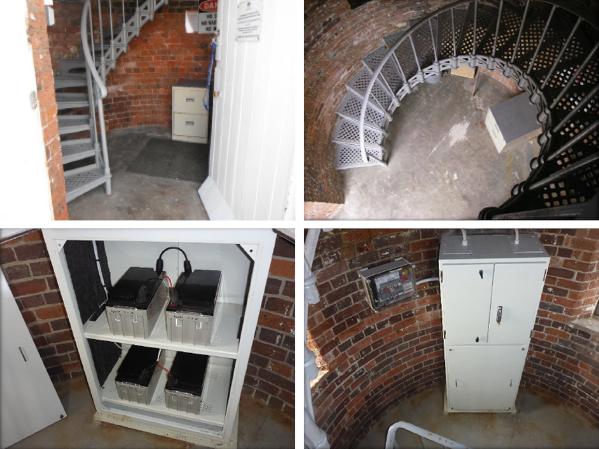
Description and condition
1889 concrete floor slab.
| Finish | bare concrete |
| Condition | intact and sound |
| Integrity | high |
| Significance | high |
| Maintenance | keep in service |
| Rectification works | none |
Heritage significance: High
The tower stairs are an original and essential part of a lighthouse associated with the development of Tasmanian townships (criterion a).
Lighthouse feature: Apron paving
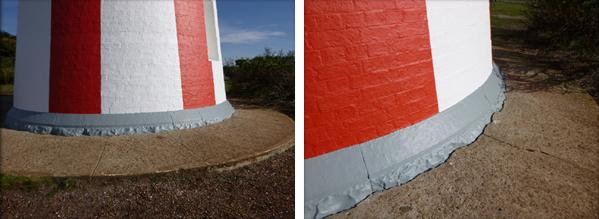
Description and condition
Concrete apron slab around the base of the tower, with white painted margin.
| Finish | trowelled bare concrete |
| Condition | stable |
| Integrity | high |
| Significance | moderate |
| Maintenance | keep in service monitor for cracks and other erosions |
| Rectification works | none |
Heritage significance: Moderate
The apron paving is an essential part of a lighthouse associated with the development of Tasmanian townships (criterion a).
4.2 Related object and associated AMSA artefact
There are currently no AMSA listed artefacts on display at the Mersey Bluff Lighthouse.
4.3 Comparative analysis
Mersey Bluff Lighthouse bears closest resemblance to Table Cape Lighthouse (TAS) built the year before in 1888. Although each of the structures maintain unique features, both were designed by Huckson & Hutchinson and constructed of brick with internal face plumb, therefore maintaining the same diameter. Both the tenders for the construction of the Mersey Bluff structure and the Table Cape lantern room were awarded to the Duff Bros. of Hobart.
Whereas Mersey Bluff was originally installed with a 4th Order Chance Bros. dioptric lens, Table Cape was installed with a 2nd Order Chance Bros. lantern. Both lighthouses were originally painted white and are located along the north coast of Tasmania.
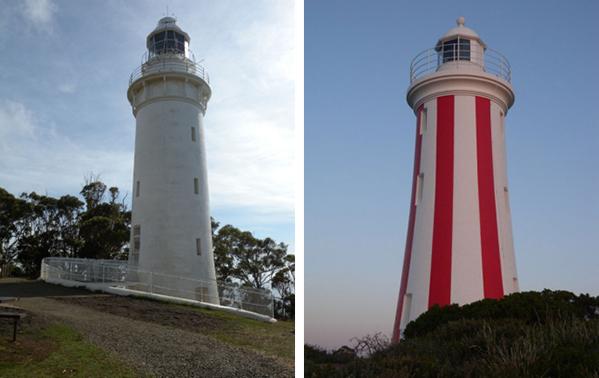
Figure 15. a) Table Cape Lighthouse (TAS) lit 1888, b) Mersey Bluff Lighthouse (TAS) lit 1889 (Source: AMSA)
_________________________________________________________________________________________________________
Footnotes
![]() 15 Australia ICOMOS, The Burra Charter, (2013).
15 Australia ICOMOS, The Burra Charter, (2013).